Abstract
Gamma interferon (IFN-gamma) can be cytolytic for normal mouse fibroblasts isolated from embryonic or adult tissue (R. Dijkmas, B. Decock, H. Heremans, J. Van Damme, and A. Billiau, Lymphokine Res. 8:25-34, 1989). This cytotoxicity has been shown to be transcription and translation dependent, thereby suggesting involvement of a suicidelike mechanism. The dose of IFN-gamma required for cytotoxicity is higher than that needed for antiviral and macrophage activation but can be reduced 10- to 100-fold by cotreatment of the cells with tumor necrosis factor or interleukin-1 (IL-1) or both, two cytokines that by themselves are not toxic for these cells. Here, we show that bacterial lipopolysaccharide (LPS), which alone has no effect on the viability of mouse fibroblasts, stimulates cell suicide induced by IFN-gamma. The effect was observed in cultures that were virtually free of nonfibroblastoid cells. LPS showed its toxicity-enhancing effect only if applied on the cells simultaneously with or immediately after treatment with IFN-gamma. Pretreatment of the cells with LPS was ineffective. Inclusion of antibodies directed against tumor necrosis factor alpha or IL-1 alpha in the culture medium did not block the cytotoxic effect of combined IFN-gamma plus LPS treatment. The time courses of cell toxicity appearance in fibroblasts treated with combined IFN-gamma plus LPS or IFN-gamma plus IL-1 were similar. In addition to LPS, heat-killed gram-negative (Escherichia coli) but also gram-positive (Staphylococcus aureus, Listeria monocytogenes) bacteria were found to enhance IFN-gamma-induced cell death. These findings suggest that IFN-gamma formed in vivo during infectious processes directly aggravates tissue destruction.
Full text
PDF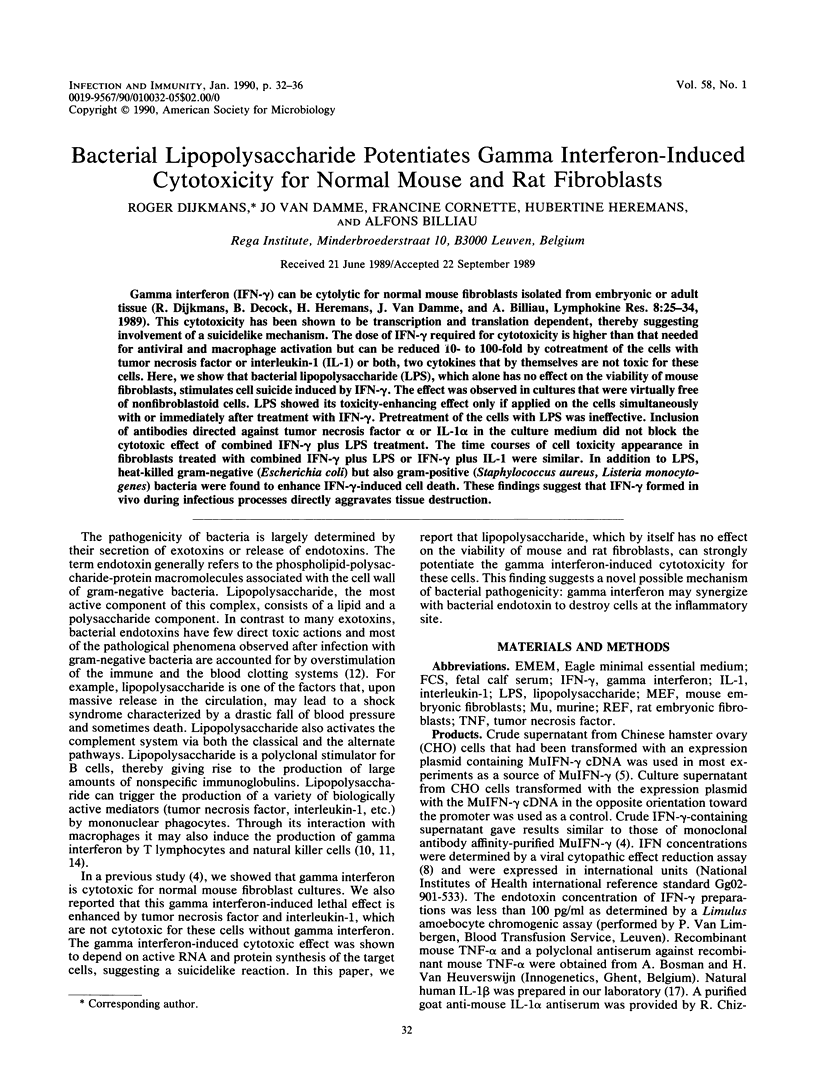
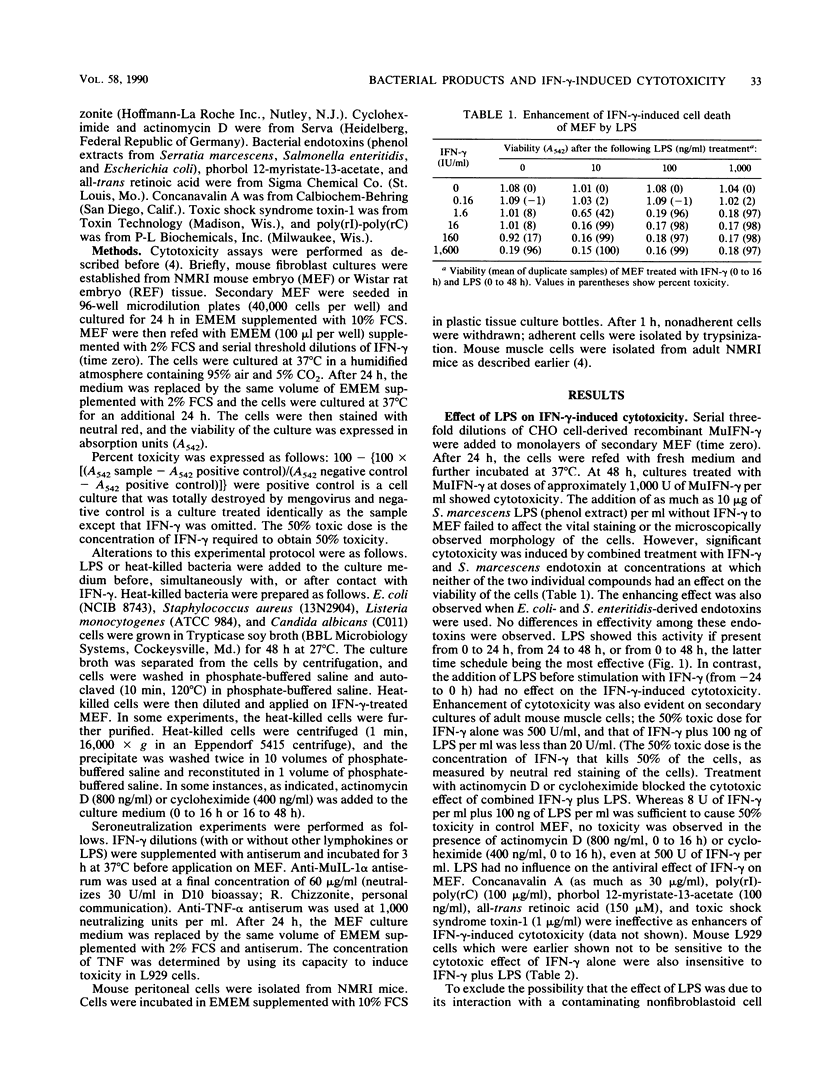
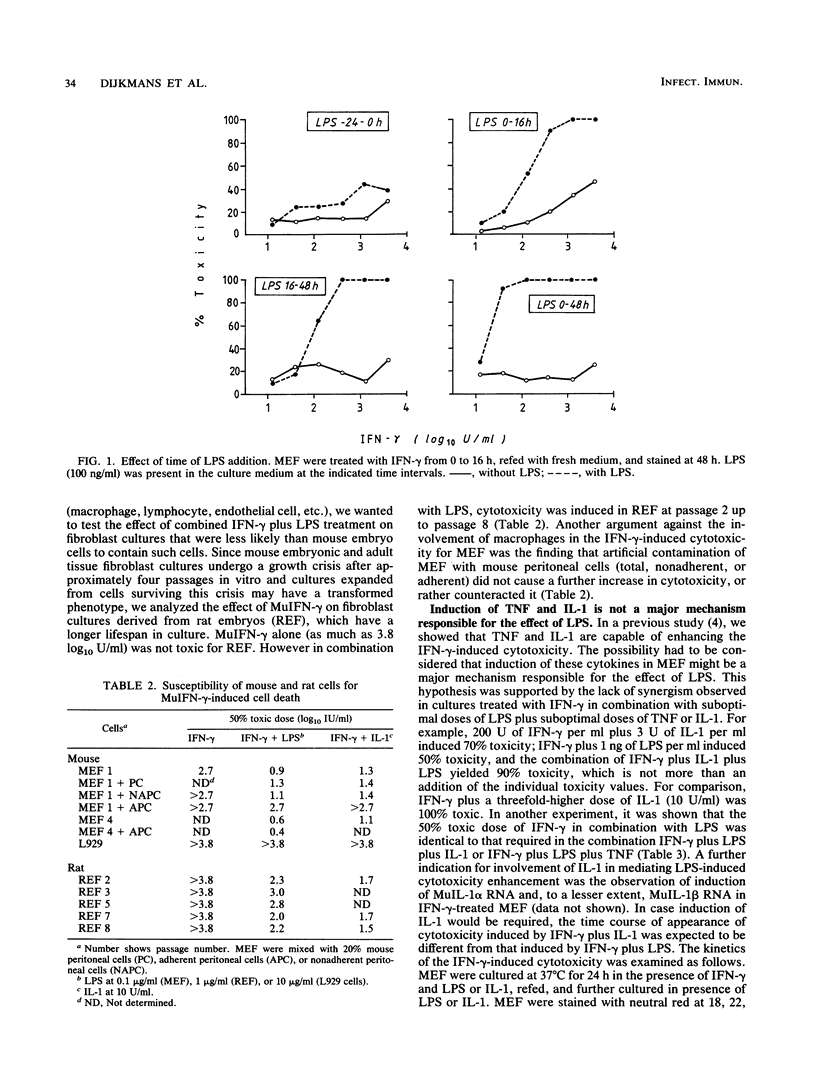
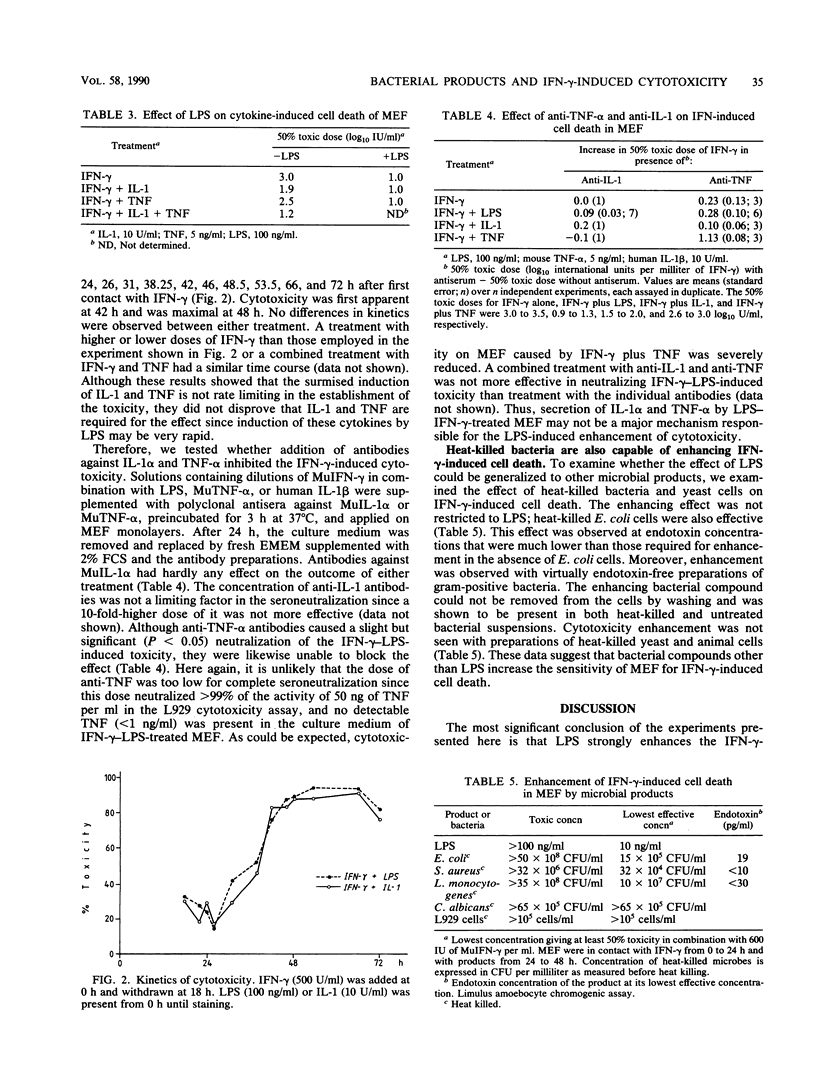
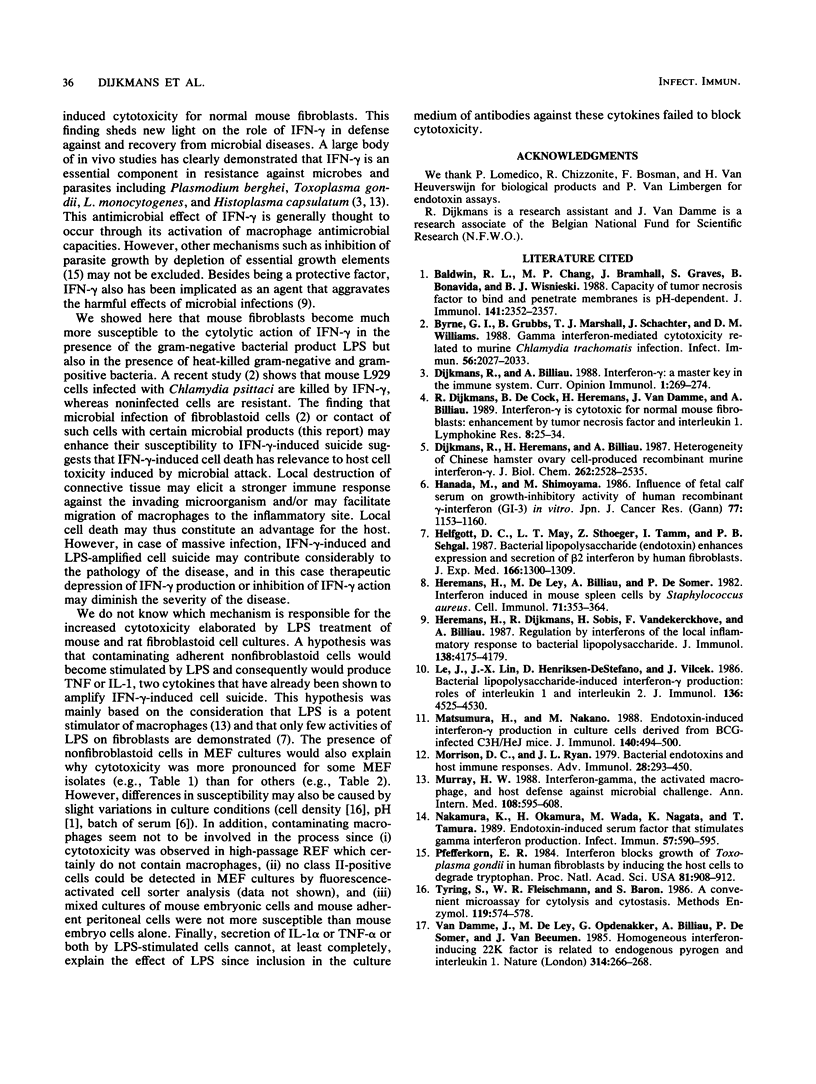
Selected References
These references are in PubMed. This may not be the complete list of references from this article.
- Baldwin R. L., Chang M. P., Bramhall J., Graves S., Bonavida B., Wisnieski B. J. Capacity of tumor necrosis factor to bind and penetrate membranes is pH-dependent. J Immunol. 1988 Oct 1;141(7):2352–2357. [PubMed] [Google Scholar]
- Byrne G. I., Grubbs B., Marshall T. J., Schachter J., Williams D. M. Gamma interferon-mediated cytotoxicity related to murine Chlamydia trachomatis infection. Infect Immun. 1988 Aug;56(8):2023–2027. doi: 10.1128/iai.56.8.2023-2027.1988. [DOI] [PMC free article] [PubMed] [Google Scholar]
- Dijkmans R., Billiau A. Interferon gamma: a master key in the immune system. Curr Opin Immunol. 1988 Dec;1(2):269–274. doi: 10.1016/0952-7915(88)90013-1. [DOI] [PubMed] [Google Scholar]
- Dijkmans R., Decock B., Heremans H., Van Damme J., Billiau A. Interferon-gamma is cytotoxic for normal mouse fibroblasts: enhancement by tumor necrosis factor and interleukin 1. Lymphokine Res. 1989 Spring;8(1):25–34. [PubMed] [Google Scholar]
- Dijkmans R., Heremans H., Billiau A. Heterogeneity of Chinese hamster ovary cell-produced recombinant murine interferon-gamma. J Biol Chem. 1987 Feb 25;262(6):2528–2535. [PubMed] [Google Scholar]
- Hanada M., Shimoyama M. Influence of fetal calf serum on growth-inhibitory activity of human recombinant gamma-interferon (GI-3) in vitro. Jpn J Cancer Res. 1986 Nov;77(11):1153–1160. [PubMed] [Google Scholar]
- Helfgott D. C., May L. T., Sthoeger Z., Tamm I., Sehgal P. B. Bacterial lipopolysaccharide (endotoxin) enhances expression and secretion of beta 2 interferon by human fibroblasts. J Exp Med. 1987 Nov 1;166(5):1300–1309. doi: 10.1084/jem.166.5.1300. [DOI] [PMC free article] [PubMed] [Google Scholar]
- Heremans H., De Ley M., Billiau A., De Somer P. Interferon induced in mouse spleen cells by Staphylococcus aureus. Cell Immunol. 1982 Aug;71(2):353–364. doi: 10.1016/0008-8749(82)90269-6. [DOI] [PubMed] [Google Scholar]
- Heremans H., Dijkmans R., Sobis H., Vandekerckhove F., Billiau A. Regulation by interferons of the local inflammatory response to bacterial lipopolysaccharide. J Immunol. 1987 Jun 15;138(12):4175–4179. [PubMed] [Google Scholar]
- Le J., Lin J. X., Henriksen-DeStefano D., Vilcek J. Bacterial lipopolysaccharide-induced interferon-gamma production: roles of interleukin 1 and interleukin 2. J Immunol. 1986 Jun 15;136(12):4525–4530. [PubMed] [Google Scholar]
- Matsumura H., Nakano M. Endotoxin-induced interferon-gamma production in culture cells derived from BCG-infected C3H/HeJ mice. J Immunol. 1988 Jan 15;140(2):494–500. [PubMed] [Google Scholar]
- Morrison D. C., Ryan J. L. Bacterial endotoxins and host immune responses. Adv Immunol. 1979;28:293–450. doi: 10.1016/s0065-2776(08)60802-0. [DOI] [PubMed] [Google Scholar]
- Murray H. W. Interferon-gamma, the activated macrophage, and host defense against microbial challenge. Ann Intern Med. 1988 Apr;108(4):595–608. doi: 10.7326/0003-4819-108-4-595. [DOI] [PubMed] [Google Scholar]
- Nakamura K., Okamura H., Wada M., Nagata K., Tamura T. Endotoxin-induced serum factor that stimulates gamma interferon production. Infect Immun. 1989 Feb;57(2):590–595. doi: 10.1128/iai.57.2.590-595.1989. [DOI] [PMC free article] [PubMed] [Google Scholar]
- Pfefferkorn E. R. Interferon gamma blocks the growth of Toxoplasma gondii in human fibroblasts by inducing the host cells to degrade tryptophan. Proc Natl Acad Sci U S A. 1984 Feb;81(3):908–912. doi: 10.1073/pnas.81.3.908. [DOI] [PMC free article] [PubMed] [Google Scholar]
- Tyring S., Fleischmann W. R., Jr, Baron S. A convenient microassay for cytolysis and cytostasis. Methods Enzymol. 1986;119:574–579. doi: 10.1016/0076-6879(86)19077-x. [DOI] [PubMed] [Google Scholar]
- Van Damme J., De Ley M., Opdenakker G., Billiau A., De Somer P., Van Beeumen J. Homogeneous interferon-inducing 22K factor is related to endogenous pyrogen and interleukin-1. Nature. 1985 Mar 21;314(6008):266–268. doi: 10.1038/314266a0. [DOI] [PubMed] [Google Scholar]


